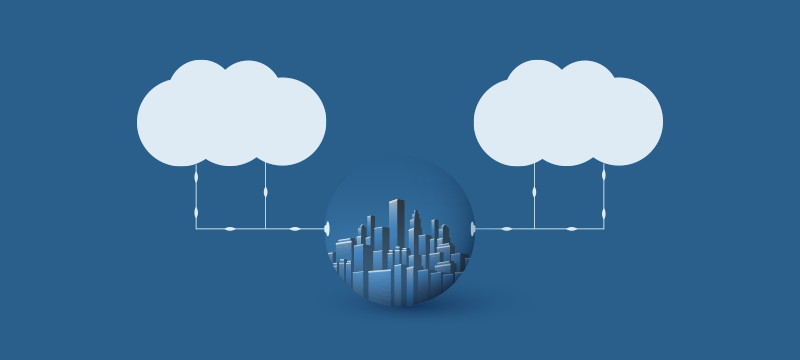The cloud is helping to transform organisations across all sectors, putting technologies like automation, artificial intelligence, big data, IoT and machine learning at their fingertips and providing them with the means to innovate quickly, offer better customer experiences and operate more efficiently. For enterprises considering adopting cloud technology, it is vital to understand the different types of cloud service that are available and also the different cloud deployment models you can choose. Here, we explain what these are.
Different types of cloud service
There are three main types of service models that cloud vendors offer. Here, we explain what they are.
Infrastructure as a Service
Infrastructure as a Service (IaaS) is where a cloud vendor provides an enterprise with the infrastructure on which to run its applications and store its data. Being cloud-based, it is a virtualised infrastructure that can be moved from machine to machine and datacentre to datacentre to ensure it never goes offline. It is also easy for a customer to scale up or scale down the IT resources they use, depending on demand. This ensures they always have enough resources to carry out heavy workloads or cope with peaks in traffic but without having to pay for long-term capacity upgrades.
With IaaS, the service provider undertakes hardware management at the datacentre and the customer can provision, customise and manage the virtual servers over the internet. This way, they are free to install, configure and manage their chosen operating system plus all the applications and tools their operations require.
Platform as a Service
For enterprises looking to develop their own applications, the most useful cloud service is Platform as a Service (PaaS). This not only gives them the infrastructure and operating system, but also the management systems and development tools required to build, test, deploy and manage their applications.
PaaS provides a cost-effective way of acquiring tools and resources while allowing dev-op teams to collaborate remotely during the project. What’s more, by building pre-coded apps into the platform, PaaS can help enterprises accelerate development and get to market quicker.
Software as a Service
Cloud-based software platforms, known as Software as a Service (SaaS), are gradually becoming the norm in business. Accessed via a browser or a lightweight computer or mobile client, they have become a highly popular choice for enterprises. Paid for as a service, customers do not have to buy the software licences or pay for annual upgrades, and with automatic updates, patches and new features do not have to be manually installed.
Importantly, the services can be accessed over the internet, providing enterprises with remote working and collaboration facilities in the knowledge that all data and files are automatically synced across the platform.
As well as well-known services like Microsoft 365, Google Workspace and Adobe Creative Cloud, there is a growing number of sector-specific software platforms available, e.g. fintech, that provide specialised services to meet the needs of different industries.
Cloud deployment models
Here we look at the four types of cloud deployment model.
Public cloud
The public cloud is the cloud most people are familiar with and the most popular type of cloud model. It is a service in which an enterprise leases virtual servers on an infrastructure shared by the cloud vendor’s customers. The infrastructures in question are vast, comprising several large datacentres, each equipped with enormous storage capacity and computing resources. This is what enables companies to have unlimited on-demand scalability and what provides the vendor with the redundancy to keep customers’ applications operating even in the event of an entire datacentre going offline.
Ideal for the majority of computing needs, the public cloud enables customers to benefit from a pay as you go payment model rather than purchase expensive hardware and run an in-house datacentre. Additionally, it provides managed services and expert technical support to relieve the burden on IT staff. For enterprises with specific requirements, it is possible to arrange managed services tailored to their needs.
Private cloud
Unlike the public cloud, private cloud infrastructure is used by a single organisation (single tenancy) instead of being shared by many customers (multi-tenancy) and it can be created either in the provider’s datacentre or in-house.
The main reason enterprises opt for private cloud is because it offers single-tenancy occupancy, which for organisations handling highly sensitive information, such as patient medical data, is needed for additional regulatory compliance. Another reason is that it gives increased control over the infrastructure, making it easier to limit access to valuable assets while enabling data and apps to be moved and stored where organisations want them.
While they can add increased security benefits, single-tenancy means private clouds are more expensive than public clouds and cannot offer the same levels of scalability.
Hybrid cloud
As the name implies, a hybrid cloud is a combination of infrastructures and applications unified into a single system. It mainly combines public and private clouds but can also include dedicated servers, with each element being used for strategic reasons.
The key advantage of a hybrid cloud is that it offers the scalability and cost-effectiveness of the public cloud, the security and control of the private cloud and if needed, the high-performance of dedicated servers. In hybrid clouds, sensitive data is securely stored in the private cloud and only moved to the public cloud for processing. This maintains compliance while reducing the costs of data analytics.
Multi-cloud
As the cloud has evolved, some vendors have begun to offer specialised services. This has led to a new way for enterprises to use the cloud. Instead of choosing a single vendor to host their entire cloud operations, they have begun to adopt a multi-cloud approach, using different providers for different reasons: for example, for their specialist service, their geolocation or simply for the cost. All these services, however, are accessed via a single, software-defined network.
Conclusion
Cloud provides enterprises with a comprehensive range of IT solutions. Cost-effective and giving access to advanced technologies like AI, ML, IoT and automation, it delivers the tools needed for digital transformation. Hopefully, this article will have widened your understanding of the different types of cloud models and services available.
For more information visit Hyperslice.com

